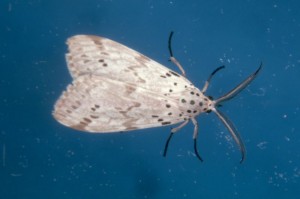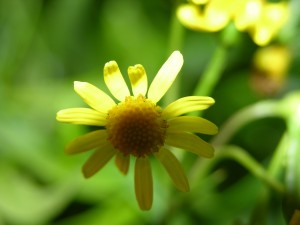Hawaii Entomologists Ramp Up Production of Moth to Control Toxic Fireweed
Posted on Dec 27, 2012 in MainNR12-15 Dec.27, 2012
HONOLULU – Hawaii ranchers are hopeful that a small beige-colored moth will be able to control the fireweed, an invasive plant that is toxic to livestock and has caused havoc on the state’s prime pasturelands. For more than 13 years, entomologists and researchers at the Hawaii Department of Agriculture (HDOA) have literally searched the world for a natural enemy of the weed that would be safe to release in Hawaii. The most promising turned out to be an insect called Secusio extensa (Arctiidae), the Madagascan Fireweed Moth, the larvae of which voraciously eats the leaves of fireweed.
It is believed that the weed came to the islands in hydromulch material imported from Australia where it is a serious pest. HDOA entomologists on Oahu have begun stepping up production of the moth after receiving the long-awaited approval from the U.S. Department of Agriculture (USDA), which came on Dec. 6, 2012. The state approved the release of the moth in 2010, but also required approval of a federal permit. The first release of the biocontrol insects is slated for early 2013, depending on the rearing of the insects in the laboratory.
“Years of extensive research have been conducted on this biocontrol program,” said Russell S. Kokubun, chairperson of the Hawaii Board of Agriculture. “Control of this weed is one of the more important issues to Hawaii ranchers, and we are hopeful that it can be controlled by this natural process.”
“Fireweed has become an even more aggressive pest during this extended period of drought,” said
Dr. Tim Richards, president of Kahua Ranch on Hawaii Island. “So it’s even more critical to our industry’s sustainability that an effective control prevents additional loss of productive pasturelands.”
In 1999, HDOA began looking for a biological control for the pretty but deadly plant with yellow daisy-like flowers, also known as Madagascar Ragwort. It is estimated that the weed has infested more than 850,000 acres, mainly on Maui and Hawaii Island. Although there are effective pesticides, it is expensive and impractical to use across hundreds and thousands of acres. Besides Hawaii, fireweed has spread through many parts of the world killing animals in Australia, Brazil, Argentina, Colombia, Venezuela, Uruguay, and Japan. Secusio will be the first biocontrol agent to be released against Madagascar fireweed in the world.
HDOA’s exploratory entomologist, Dr. Mohsen Ramadan, traveled to Australia, South Africa and Madagascar in 1999 and returned with 14 insects and one fungus, which were researched and tested under quarantine conditions. Some were found to be ineffective, while others were found to harm other native or beneficial plants. Dr. Ramadan traveled to the region again in 2005, 2007, 2011 and 2012 to look for more potential biocontrols for fireweed and other pests, such as coffee berry borer, small hive beetle and the protea mealybug.
Entomologists and staff in Honolulu were busy not only trying to keep the quarantined pests alive, but it also meant that they also had to grow the fireweed to host the moths. HDOA is also testing four other potential natural enemies of fireweed, each which appear to attack different parts of the plant.
“Until now, we have been able to keep generations of this moth alive under quarantine conditions,” said Darcy Oishi, section chief of the Biocontrol Section. “We have now switched gears and begun to ramp up production to increase the chances of successful control of fireweed. With the support of the ranchers and others, we hope to release more than one million moths this year.”
“Biological control of pests can be the most efficient and cost-effective method to manage significant pests,” added Dr. Neil Reimer, manager of HDOA’s Plant Pest Control Branch. “Since 1975, HDOA has released 51 biocontrol agents and all have been successful and none have been found to attack anything but the target pest or weed.”
“Fireweed has proven to be highly invasive and in certain areas has reduced the forage production by as much as 60 percent,” said Dr. Mark Thorne, state range specialist with the University of Hawaii – College of Tropical Agriculture and Human Resources. “With the pending release of Secusio, ranchers will have a valuable tool that will help them recover some of the economic value of their pastures.”
Biological control, which utilizes natural plant enemies and/or diseases, is needed in natural and managed ecosystems as a tool for managing invasive plant species that are too widespread and expensive to control using herbicides and/or mechanical removal methods. Although challenging to implement, effective biocontrol can provide long-term, large-scale, highly selective control of otherwise prolific weeds. Current research methods thoroughly test potential biocontrol agents prior to release to ensure that they only attack the target weed and not other native or beneficial plants or animals.
Hawaii continues to be a leader in biocontrol of pests. The Kingdom of Hawaii was a world leader in biocontrol with successful introductions of a beetle to control cottony cushion scale in 1890. After Hawaii became a U.S. territory in 1900, biological control methods progressed with the introduction of several insect species to control lantana in 1902. Since then, researchers in Hawaii continue to be internationally recognized in biological control of weeds and plant pests and have collaborated with colleagues worldwide on the biological control of invasive weeds and pests such as miconia, fountain grass, banana poka, ivy gourd, gorse, wiliwili gall wasp and nettle caterpillar, among others.
###
 |
 |
| Larvae (caterpillar) stage of the Fireweed Moth | Adult Fireweed Moth |
 |
 |
| Fireweed flower | Fireweed plant |
